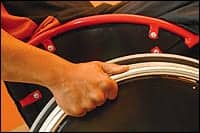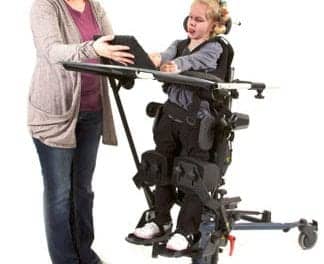
With so much uncertainty surrounding health care reform, I feel as though I’m looking down a long tunnel. There is a light at the other end, but I cannot discern any of the images. The unknown only adds to the laundry list of items wheelchair professionals are worrying about every day: Competitive bidding goes into effect in January 2011; the fight to keep the first month purchase option for standard power wheelchairs; the continuing effort to obtain a separate benefit category for complex rehab; the creation of a document that would provide peer-reviewed and published guidance on the wheelchair service-delivery process; and the continuing effort for the recognition of wheelchairs and seating and positioning as a specialty within the APTA and the AOTA.
PROVIDERS STAY THE COURSE
Despite all of the uncertainty, the providers in my area appear to be stable and ready to take on whatever is to come. They know that beneficiaries need their products and services and that good health care professionals will continue to do right by their patients. Some are looking for ways to create a more diverse income source and are exploring ways to create more cash sales for medical equipment items.
PHYSICIAN DOCUMENTATION IS IMPROVING
 |
| Jodie Stogner, PT, ATP |
The physician’s face-to-face requirement for power mobility is becoming more accepted by physicians who were so accustomed to writing an order that simply read “wheelchair” with a length of need listed as “lifetime” and forwarding it to a supplier along with a Certificate of Medical Necessity (CMN). In reviewing some power mobility claims, I have been stunned at the thoroughness of the doctor’s encounter note with regard to documenting the mobility assistive equipment criteria. So much so that, on occasion, I asked the supplier: “Are you sure the doctor wrote this?” They are head and shoulders above the visit notes that were seen even a year ago that read everything from vital signs to medication effectiveness with no mention of the person’s mobility or function. However, I often hear at seminars that difficulty in getting face-to-face notes from physicians remains.
COMPETITIVE BIDDING MOVES FORWARD
The bids are in for the first 10 MSAs (Metropolitan Statistical Areas), and the winning bids will be announced this summer with the winning contracts being announced in the fall. Implementation begins in the first nine areas on January 1, 2011. The newly passed health care reform package expands the competitive bidding process to 91 additional areas or MSAs and requires competitive bidding prices to be applied in all areas by 2016.
How will this affect your patients and your ability to perform your job effectively? It will require you to use the contracted supplier who won the bid for the particular product you are recommending. This supplier may not be the supplier of choice for the beneficiary or a supplier you are accustomed to working with. The supplier may even be located more than 100 miles from the beneficiary’s home, which creates obvious issues regarding follow-up service.
Here’s a clinical scenario: A 72-year-old male has a stroke and is now ready to be discharged home with home health services. The rehab team is recommending the following items: a standard walker, hospital bed, wheelchair, and feeding tube. He has developed a pressure ulcer while in the hospital and needs a Group 2 mattress/support surface for his bed and he is on 24-hour oxygen. In this scenario, the discharge planner will have to contact the contracted supplier for each item that is in the competitive bid product category, which is all the items listed above except for the manual wheelchair. Suppliers, more than ever, have to ask for medical records to support the request of each item. The discharge planner would have to gather the medical records that support each item and forward the appropriate information to the corresponding supplier. The beneficiary or their family will have to keep up with who supplied what in order to receive service for that item. They can no longer call one supplier for all necessary items. The beneficiary will have five different suppliers delivering equipment to their home upon discharge. What if a beneficiary already has items in their home and has been satisfied with the service they have been getting from their supplier? The new contracted supplier will need to replace the equipment furnished by the existing supplier. This all amounts to a logistical nightmare for the beneficiary, care coordinator, and caregivers.
THE REMOVAL OF THE FIRST MONTH PURCHASE OPTION
There is hope that the industry will find support for a legislative “fix” to restore the first month purchase option for Group 1 and 2 power wheelchairs, but there is no vehicle for this.

To read about the latest issues affecting the mobility industry, search our online archives.
Currently, upon delivery of any Group 2 or lower noncustomized power chair, a supplier presents a document to the beneficiary that allows them the choice to rent or purchase the equipment. Since most individuals who need power mobility have long-term medical conditions requiring the assistance of the equipment, the title is generally turned over to the beneficiary 95% of the time. The new health care reform law takes this initial purchase option away and implements the power wheelchair item as a 13-month capped rental. This means that the chair belongs to the supplier until the 13th month when the beneficiary takes ownership.
How does this affect clinicians? Say you have two individuals who both weigh less than 300 pounds. One client is 5 feet tall, the other is more than 6 feet tall. Obviously, even without taking any physical measurements, common sense would say that these individuals would require different seat dimensions specific for their physical presentations for comfort, pressure reduction, and prevention of secondary medical complications such as spinal curvatures. Without the first month purchase option, the beneficiary has to receive whatever is in the supplier’s rental inventory fleet. As a clinician, what good is an evaluation and recommendation for an appropriate patient-product match if the supplier cannot afford to order a patient-specific power wheelchair and the patient doesn’t have access to appropriate equipment over a lifetime medical need?
Because capped rental items are not a covered benefit during a Part A stay in a hospital or skilled nursing facility, the supplier has to pick up the unit, clean it, and return it to their inventoried fleet should the beneficiary be admitted. Even if the initial product from the rental fleet is a good fit for the patient, there is no guarantee they’ll get the same unit back after they are released.
Not only does the supplier have to wait 13 months to receive full payment for a product, they are also financially responsible for the repair and maintenance of their rental inventory. This will place a great financial burden on providers and may force many of them to close, leaving the client with fewer options.
With an understanding of what is at stake for clients, rehab professionals, and providers, it is essential that we contact legislators and let them know how these measures impact our industry and those we serve. Only then can we see a clear future at the end of the tunnel.
Jodie Stogner, PT, ATP, is the founder and owner of Southeastern Assistive Technology Solutions LLC and Southeastern Assistive Technology Solutions Consultants LLC, Jackson, Miss. For more information, contact .





